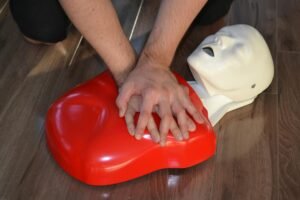Being able to perform child CPR is a vital skill that can help save a life. Essentially, the bones of children are more flexible than adults while their tongues are bigger in comparison to their mouths while the airways are thinner. Due to these features and the likelihood for children to place foreign objects in their mouths, they are more likely than adults to require CPR due to a blocked airway.
Most of the techniques utilized for children aged 1-8 years are similar as recommended for adults. When it comes to child CPR, it is vital that you are familiar with the steps to perform.
Start child CPR before calling for emergency assistance
It is recommended to perform CPR right away on a child if you are the only one present and you have to decide between starting CPR and calling for emergency assistance. The reason for this is that children are more resilient than adults and their chances of survival if given immediate CPR is higher.

If alone, call for emergency assistance after delivering CPR to a child afterwards 5 compressions with breath cycles which must last for approximately 2 minutes. If there are others around, ask someone to call for emergency assistance while you perform CPR.
Rescue breathing
The airways of children are generally more fragile than adults. With this in mind, you have to be careful when delivering rescue breaths to a child and not to tilt the head too far back. Take note that this can actually block the airway further particularly for smaller children. Be careful when tilting the head back and breathe gently.
Compressions
Depending on the size of the child, you can utilize one or two hands to deliver compressions. Since children have miniature chests than the adults, the deepness of compressions must be only 1 ½ inches. The compression and the breath rate must be the same for children as with adults – 30 compressions to 2 breaths.
Quick Note / Disclaimer
The material posted on this page on child CPR is for learning and educational purposes only. Learn to manage and help a child during emergencies that require CPR by taking a standard first aid course in one of our training centers.
Quick Note / Disclaimer
The material posted on this page on breathing emergencies, including anaphylaxis and allergic reactions, is for learning and educational purposes only. To learn to recognize, manage and help individuals with severe allergic reactions register for a first aid and CPR course with Edmonton First Aid.
Is AED needed?
If there is an on-hand AED, it can be used after 5 cycles or about 2 minutes of performing CPR. If pediatric pads are available, they can be used.
